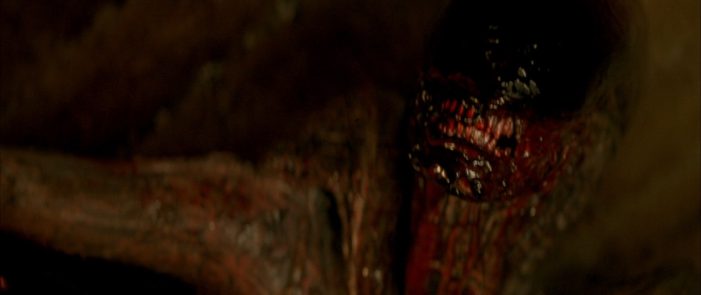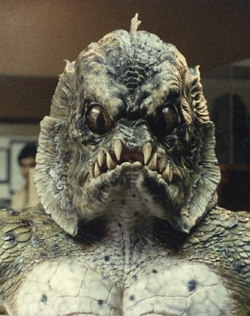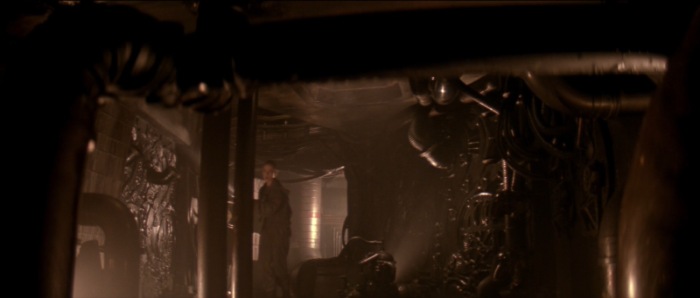Tom Woodruff Interview
Posted by Darkness on November 27, 2021 (Updated: 22-Aug-2023)
Tom Woodruff is the co-founder of special effects studio, Amalgamated Dynamics Inc, along with Alec Gillis. They worked on Aliens under Stan Winston before forming they’re own studio. They’ve worked on many films since then including handling the effects on Alien 3, Alien Resurrection, AvP, AvP Requiem and The Predator.
We originally did an interview with both of them back in December 2006, Next, RidgeTop visited the StudioADI workshop in December 2017 and produced a report and video interview with both of them. We interviewed them earlier this year in April 2021. RidgeTop and Corporal Hicks have now interviewed Tom Woodruff on his own for Episode #136 of the AvPGalaxy Podcast. You can watch the episode below or continue on for a transcription of the most important parts. This interview is more focussed on Tom Woodruff inside the costumes.
 Aaron: Not only are you responsible for designing and making these suits, you frequently perform inside them. So, we talked about what led you into making monsters when we spoke last so now let’s ask why you wanted to be the monsters?
Aaron: Not only are you responsible for designing and making these suits, you frequently perform inside them. So, we talked about what led you into making monsters when we spoke last so now let’s ask why you wanted to be the monsters?
Tom: Yeah, I know that before I wanted to make monsters, I wanted to be a monster. My story, my history which I’ve mentioned a number of times but it’s not that different from everybody else’s. As a kid, a five- or six-year-old watching the creature from a Black Lagoon or watching some gorilla movie from the 40’s, I wanted to do that. I wasn’t thinking I want to build that but I know there’s a guy in that gorilla suit.
So why couldn’t I do that someday or I want to play the Frankenstein monster. So it really started out as me wanting to copy what I started to associate with as my personal heroes on tv and in movies. Then the next step was figuring out that somebody had to build those suits and design those suits because I just wanted to be in on everything,
Adam: I doubt many creature performers also have the experience and knowledge of what goes into making their costumes. How does the duality here affect your performance or your costume making – just that you’re also involved in the construction of these costumes, but you have to perform in them? Are you thinking about how you’re going to perform when they’re being designed?
Tom: Yeah, well absolutely. As soon as we’re able to get a test skin out whether it’s a hand or a body or something we’re in our mirrored room so I could put it on. Even before it was trimmed or painted or anything because it’s like that that clip of Pumpkinhead in the white foam Pumpkinhead suit that hadn’t been finished. I’m climbing around on a worktable in Stan Winston’s shop. That was really important to get comfortable with the suit whatever the construction of that suit was.
So, I could see it as more than just a suit. When we would build things, we didn’t build anything special because I was in it. In fact, we took shortcuts that we wouldn’t take if these suits had to go on a stuntman or go on some other performer. I’m talking about things like – there were times when I would have to wear a harness to do wire stuff. Normally you would build space into a suit because stunt men would take those wire harnesses. They were literally like a 2″ webbing straps and they would wrap them in sheepskin to displace some of the pressure like across the tops of their legs and their chest, but I could always see that little bump.
Even though it was small, I could see it in the suit and the sleeker the suit was, the more obvious it was. So, we said okay, if I’m in a suit, we pulled all the lamb’s wool, the padding off of it and it was just me and the webbing. At the end of the day, I would have these red chafe marks and everything, but I didn’t care because I thought it was cooler. I’m so detail oriented I’m probably seeing details that others don’t know but then again, I don’t want to just have… even if it’s just five people in a theater that notice it, I want to avoid that. So, if anything else, we would take shortcuts that would advance the reality of the creature at the expense of my comfort.
Aaron: That was something you did with Alien 3 as well, weren’t it? I mean you were willing to stay inside that suit so you didn’t have to pull up the glue and ruin the suit and stuff like that.
Tom: Yeah, part of that is the duality is being true to the character of whatever monster I’m playing. At the same time not wanting to reveal that ADI built something uncomfortable, or they built something that a stunt man would want in and out several times a day. I told Alec we’d just glue it in, and I’ll stay in, and I don’t care. It preserves the glove; it preserves the wrist. Part of that was allowing us to build things fast and inexpensively because we didn’t have to have multiples and we didn’t need to make it all comfy. So, it was like trying to cover two masters at one time.

Dog Alien from Alien 3.
Aaron: Let’s talk about Alien 3, then. That was the first time you suited up inside the alien and I think it’d be fair to say that unlike the Predators, you had Predator and Predator 2 at that time. Unlike Predator, aliens themselves didn’t really have much in the way of on-screen reference for performance as such for you to have referred to then. I mean it was mostly what quicker close-up shots in Aliens or the footage of suit work in Aliens was the stunt work. Did that make it difficult for you to prepare for Alien 3 not having that same amount of visual reference of people in the suit?
Tom: No, it didn’t. I mean if anything it kind of fired me up to give me the ambition, to give me the self-confidence to go to David Fincher and say I want to play this. I played these other creatures when I was with Stan Winston because on Aliens, it bothered me when we’re setting up the suits on the stuntmen up in the ceiling of the of the Med Lab. All these stuntmen are all on their wires and stuntmen are not the skinniest guys. So, me of them are very muscular some of them are just kind of fit in the middle.
They’re not that kind of a real slim physique but we put these suits on and they’re up in the ceiling. We’re all getting ready to go and then somebody rings the belt and it’s time for tea. It’s like “Oh we have to stop now for 10 minutes.” So, everybody is passing up these greasy sausage sandwiches to the guys up in the roof. These guys are eating, and you just know that they’re making a mess out of everything and then we went ahead and shot the scene. The truth is, it didn’t matter because Cameron knew it was gonna work this way, but they dropped through the ceiling.
There’s smoke. There’s light. There’s camera movement. You could have thrown an empty alien suit out because there was nothing about the performance or the physicality other than a humanist figure falling and landing on the ground. So, when I saw that I thought “Wow if I get a chance to do this, I’m going to come up with some really cool moves.” I wanted to be able to about to see the alien in more of a longer shot even if it’s just a few seconds longer to capture what that thing looks like on screen.
Adam: Yeah, you didn’t really get too much of a focus on the warriors in the second film. It was all very quick and very fast. I mean you did get that more with the Queen Alien but yeah in the second film, they were so quick whenever the warriors were on screen.

Gill-man from Monster Squad.
Aaron: Have you done any creature performance when working on Aliens?
Tom: Yeah, when I had started, I was at Stan’s, I started with the Gill-man from Monster Squad and then I can’t remember if Leviathan came next or if it was Pumpkinhead. Anyway, three creatures and some stuff like that.
Aaron: So, it was on your mind then while working on that film about playing an alien?
Tom: Oh yeah absolutely was. It’s like when I worked with Stan, it was under the umbrella of him caring enough to go to production on like Gill-man and say “Hey I’ve got this guy…” I’d already made a life cast on my own body. I didn’t do it myself. I had it made by my friends and I said “Look Stan, we got this body cast, we’re going to save so much money if you let me play” but he was great. That gave me confidence that he was going to put his name on the line and say try this guy out. So, that was that was that was really a big moment to be able to start doing that.
Aaron: So, in terms of prep then for suiting up for Alien 3 being inside that suit for the first time. How much of that was sort of dictated by what you were reading in the script versus what you were able to bring into it yourself? What was those early thoughts?
Tom: Well I knew going into it that these movies rely on short fast clips. If there’s not a big action thing happening, you normally are not going to see it. Fincher did work in moments of like an alien, I forget how far into the movie, towards the end when everything starts falling apart but the alien has captured somebody here and here’s somebody else. He turns around and Fincher would give the creature those kind of moments. I hope it was because the suit would hold up to it because you never can just walk around.
A guy can’t just walk around, like walking down the street. I’m an alien because I have a long head and a tail on and you kind of fit everything else in between but that was pretty cool. So, I would try to come up with some cool things and it was always shot from the waist up. We knew that the man type… pelvis and legs would never show unless it was on the rod puppet. So, I was doing things where I would lean way over to try to move and just make it as non-human. I was just going for a non-human and I was also a big fan of Ray Harryhausen and I used to think of all of his creatures.
Even if they’re standing, they have just a little bit of movement to him, and I would do that. If Fincher said “Walk down this hall. Stop on this mark.” I would walk down the hall and as I get to the mark, I’m trying to picture what’s the cool pose of the alien because that to me, it’s like a frame of the comic book. So, I have to go from page one to page two and as I’m approaching page two, I know it wants to be this. So, I would come up to that kind of a movement at the end.
Adam: Continuing on with Alien 3, there’s a scene with Ripley in the basement where she seeks out the xenomorph after realizing she’s been implanted. We know that originally the scene went on for a bit longer than in the film where it cuts away right after it drops from above. We were wondering if you could elaborate on how the full scene originally played out.
Tom: I do remember that scene. To me the biggest thing about that scene was – they built a little shelf for me above the camera right. So, the shelf’s up here. I’m laying up here. Cameras down here. So, when they give me the cue, I could kind of drop down in front of the camera right and then stand up or cut, I forget but anyway I was in that thing. I was in the suit. My face was down. I had the foam rubber neck. So, I’m laying up there and we do take number one and I’m still totally enamored with Sigourney Weaver.
Back then, it was like “Oh my god, this is the most beautiful girl in high school and she’s going to go to the prom with me or at least let me finish asking her before she says no”. So, she comes into the scene and I’m just lying there going “Oh my god, I’m watching Sigourney Weaver and she’s doing the whole thing.” I find myself just starting to kind of get drowsy and I think the first scene was an alien and I’m just lying there and then they cut, and I said “Sorry, I missed my time.” I don’t want to say I fell asleep.
I talked to Alec about it, and I said “I think I’m gassing out because there’s no air moving around up there. When I lay my head down and squeeze into this thing my face is pressed in the neck so I can’t get fresh air. So, I think I’m breathing more carbon dioxide than I am taking in oxygen and I’m just slowly… passing out is too dramatic… falling asleep is too light but it’s somewhere in between. So, Alec would stand at the other end of this shelf where my feet were. When they said alien, he would pound my feet so I would feel it through the rubber and then I would just move.

Ripley finds the alien hiding above the pipes in Alien 3.
So, was hard to just figure out that come to terms with that where then it was okay because it was just dropping in front of the camera. Had it been something where the alien had to make some more of a presence. Yeah, it could have been a real problem but beyond that, I know that there is a cut from that shot. I know there was stuff beyond that, but I don’t remember exactly what it was. I don’t remember exactly what it was, but it wasn’t anything that changed the trajectory of the story or Ripley’s character. I think it was just time had to come down.
Sigourney was a real champion of urging me on to treat the alien like a character and not just be a guy in a suit. I remember that came about mostly when there’s a scene where the alien is tucked back in the in the hallways leading to the lead mold. Sigourney is approaching it with the flare and I’m reacting. I’m trying to watch that, and Fincher just wants a lot of crazy movements.
I remember after take, Sigourney said Let’s talk about our characters” and I started to get like choked up thinking “Oh I’m a character.” But she was so gracious in saying “It’s not just about what Ripley’s doing, it’s about what Ripley’s doing in connection with what the alien’s doing.” From the very beginning, she wanted me to approach it like an actor and think beyond just how long am I gonna keep throwing my arms around before Fincher yells cut. So, that was a great aspect of working with her so early.









